April is Poetry Month, so it’s the perfect time to teach poetry. After implementing these strategies, you’ll be amazed at how quickly your students are able to read, write, and understand poetry… and even more surprised to discover how much your students come to love poetry, too! Most of the activities were designed for upper elementary students, but many can be adapted for younger or older students. Even if you haven’t enjoyed teaching poetry in the past, you might find yourself looking forward to your next poetry unit! The live webinar is over; click HERE for the replay!
Fluent readers not only sound more expressive when they read aloud, but they also comprehend the text far better…
Read more
Do your students groan when it’s time for spelling? Spelling might be an important subject,..
Read more
Have you ever asked your students to write a story with their spelling words? It may not seem like the most …
Read more
 Seek & Spell Challenge
Seek & Spell Challenge
(Aligned with CCSS for grades 2-5)
Includes Editable Templates
Seek & Spell Challenge is an engaging word work strategy that’s so fun your kids won’t even know they’re learning! Students try to find the mystery word (and other words) in a set of letters tiles. Includes printables for 36 mystery words. Click here to see it on TpT or preview it online now.
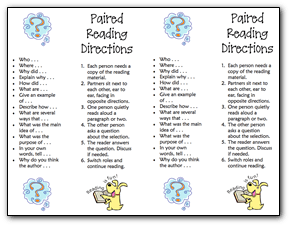 When I’m using the Balanced Literacy Framework for my reading instruction, I use the first 30 minutes of my Literacy Block to introduce new skills and use direct teaching methods. Some days I introduce new spelling words or conduct word wall activities. I may assign partners and do Paired Reading, or have students use a cooperative learning structure to discuss a story. Sometimes I read aloud and model my thinking. For Paired Reading, download the bookmark page and cut it in half. Fold each half in half again and glue to make a double-sided bookmark.
When I’m using the Balanced Literacy Framework for my reading instruction, I use the first 30 minutes of my Literacy Block to introduce new skills and use direct teaching methods. Some days I introduce new spelling words or conduct word wall activities. I may assign partners and do Paired Reading, or have students use a cooperative learning structure to discuss a story. Sometimes I read aloud and model my thinking. For Paired Reading, download the bookmark page and cut it in half. Fold each half in half again and glue to make a double-sided bookmark.
After the whole group instruction, I divide my class into 3 reading groups, generally based on ability. However, the groups are flexible and may change from week to week depending on the needs of the students. I meet with all three groups every day, even if it’s just for 5 minutes. I generally meet with them 17 or 18 minutes with a few minutes of transition time in between. During my small group meetings, I conduct guided reading lessons or work with the group on a particular reading strategy or skill such as how to conduct research or identify fact and opinion. My small group instruction generally relates to the whole group lesson. For example, if we worked on making predictions in the whole group lesson, my guided reading lesson would provide additional work with that strategy. If I’m using Literature Circles, this is the time when I meet with each group. I have a large rectangular table in my room that I use for my small group meetings. During the meetings, students take turns reading aloud and I provide assistance with developing fluency or working on comprehension. For some great ideas and specific small group lessons, read Making the Most of Small Groups.
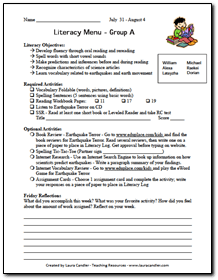 Centers are sometimes called Stations in the upper grades. In my classroom, these are activities rather than physical locations in the room. I don’t have enough room to have permanent centers with trifold boards or other displays; most of my centers are contained in laminated manila folders or brown envelopes and can be taken to any location in the room. At the beginning of the week I provide each student with a Literacy Menu (see samples). Each group’s menu is slightly different and based on their needs. The menu lists all required centers and activities for the week along with a list of suggested optional activities. (To simplify this, you could create a single menu and tell each group which items were required during your meeting on Monday.) Students keep all reading materials in their Literacy Log, a plastic folder with pockets.
Centers are sometimes called Stations in the upper grades. In my classroom, these are activities rather than physical locations in the room. I don’t have enough room to have permanent centers with trifold boards or other displays; most of my centers are contained in laminated manila folders or brown envelopes and can be taken to any location in the room. At the beginning of the week I provide each student with a Literacy Menu (see samples). Each group’s menu is slightly different and based on their needs. The menu lists all required centers and activities for the week along with a list of suggested optional activities. (To simplify this, you could create a single menu and tell each group which items were required during your meeting on Monday.) Students keep all reading materials in their Literacy Log, a plastic folder with pockets.
Note: 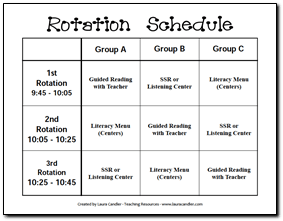 If you would like to use one of my sample Literacy Menus and modify it for your own use, feel free to do so. You can’t modify the PDF files, so I’m including an example in Microsoft Word format.
If you would like to use one of my sample Literacy Menus and modify it for your own use, feel free to do so. You can’t modify the PDF files, so I’m including an example in Microsoft Word format.
Note: Some weeks I don’t use a menu, especially if I want students to do specific activities on certain days. For those days I use a Rotation Schedule Chart so that everyone knows what they are supposed to be doing during each of the 3 rotations.
For more ideas on how to implement and manage Literacy Stations, I recommend Debbie Diller’s books Literacy Work Stations and Practice with Purpose shown at right. They’re both excellent resources.
If you only have 60 minutes and you want to use a balanced literacy approach, you can experiment with alternating whole group instruction with small groups and centers. For example, teach a whole group lesson on Mondays and Fridays and do small groups and centers on Tuesday, Wednesday, and Thursday. Use one of the two planning pages located at the bottom of this page to help you organize instruction. Use a Rotation Schedule Chart each day to post information about who will be going to what activity during each rotation.
Post a chart in the room that clearly states what each group is supposed to be doing during each part of the small group instruction block (see example). I have found it helpful to rotate students through 3 basic activities: Guided Reading with me, Self-selected Reading or Listening Centers, and Literacy Menu work. The most active part of the block is when students are working on their Literacy Menus because the choices include games and partner activities. By using the Rotation Schedule I can ensure that only 1/3 of the class is involved in centers at a time. One third are with me and the other group is doing SSR or a Listening Center.
My timer is indispensable! I have a Time Tracker I obtained from Scholastic using bonus points. I can set it for a specific number of minutes, and it starts with a green light showing, followed by a yellow light, and finally a red light. It announces “Times Up!” when the time runs out. I set it for 16 to 18 minutes when the kids sit down at the table and it keeps me on track. When the light turns yellow, we know we have to wrap up the session in a few minutes.
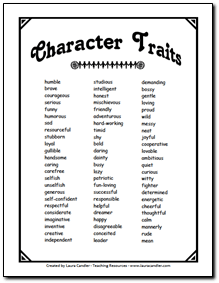 Literacy Folder or Log
Literacy Folder or LogStudents need to keep a pocket folder for storing their Literacy Menu and all related assignments. I collect these on Friday and use them for assessment. I require my students to bring a plastic folder with paper fasteners. Plastic is durable, and the paper fasteners are needed for storing handouts like my list of Character Traits or their Genre Study sheets.
Outline specific requirements for where students may go during the Center Rotation time. For example, the students who are doing SSR are allowed to take foldable camp-style chairs or pillows to various locations in the room while they read. They may not cluster together on the carpet. Students who are doing menu activities may work at a specific table or on the carpet.
I have a rule that I am not to be interrupted during Guided Reading. We take a bathroom break right before the Literacy Block. If they want to go to the Media Center they get a pass, walk into my line of vision, and hold up the pass until I nod. If they have a question, they ask someone in the room or wait to ask me between rotations. You have to be vigilant about this rule or kids will constantly interrupt you which is extremely frustrating..
I have several plastic storage carts with sliding drawers. I store my laminated packets of Literacy Games and other materials in the drawers to keep things organized. I also have a collapsible sweater shelf-style rack hanging from a hook at the front of the room. It won’t hold a lot of weight, but it will hold a few center games and worksheets for that day’s activities.
An activity I created for my 5th grade students and I later compiled it into a free packet to share with other teachers. It consists of student directions, an oral fluency chart, and a fluency rate line graph. The activity can be completed in a literacy center by students working in pairs or by an adult working with a student. Directions are included in the packet. In addition, you’ll need leveled reading selections and a timer. Store the materials in a bag or container and place one of the labels on the packet for easy reference. Click the image below to download a free copy of this packet.
An engaging word work strategy that’s so fun your kids won’t even know they’re learning! Students try to find the mystery word and as many other words from a set of letter tiles. Learn more about it and download a free set of Seek & Spell Challenge word work printables from this blog post on Corkboard Connections.
Partner activity for reviewing spellings of Word Wall words. Student directions are on the gameboard. Duplicate on cardstock, laminate and students can use dry erase markers on the board.
This activity is a fun way for students to practice identifying genres. You’ll need to print out the 7-page file and glue the directions and pages 3 – 5 onto sheets of construction paper. Laminate them, and make copies of page 2. Students will place the steps of the genre walk in order on the floor. They read a short book with a partner (leveled readers work great) and then follow the steps of the Genre Walk, discussing each question as they go.
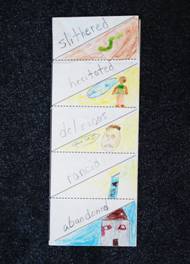
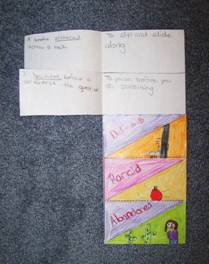 Print out the blank foldable and duplicate for all students. Students fold the page in half hot-dog style and then cut 5 “flaps” by snipping the 4 dotted lines. They should orient the folded page vertically and write each vocabulary word in the top half of one flap. They open the flap and write the definition of the word under it. Finally, on the front of the flap below the word, they draw a picture or symbol that will help them remember the word. This format allows them to study their words by opening and closing the flaps. Download the directions below for complete instructions and a sample.
Print out the blank foldable and duplicate for all students. Students fold the page in half hot-dog style and then cut 5 “flaps” by snipping the 4 dotted lines. They should orient the folded page vertically and write each vocabulary word in the top half of one flap. They open the flap and write the definition of the word under it. Finally, on the front of the flap below the word, they draw a picture or symbol that will help them remember the word. This format allows them to study their words by opening and closing the flaps. Download the directions below for complete instructions and a sample.
Vocabulary Foldable Directions/Sample
Vocabulary Foldable – 2 pages with labels
Vocabulary Foldable – 1 page without labels
Through grants and parent donations, have obtained several inexpensive personal CD players for my classroom, and these are used by individuals or small groups of students. The basal reader selection is on CD, so I always have my struggling readers listen to the story on Monday during their center time. I also have a collection of CD’s for novels such as Hatchet and The Bad Beginning. I discovered that you can get anywhere from 2 to 6 students to listen to a single CD player if you have multiple headphones and “headphone splitters.” I purchased the headphone splitters at Walmart and Radio Shack; they are y-shaped connectors that allow more than one student to plug headphones into a CD player. By stacking the splitters you can increase the number of students from 2 to as many as 6 kids listening to a single CD! The great thing about Listening Centers is that when students have headphones on, they are completely quiet and stationary rather than roaming around the room bothering others! (Note: if you write grants or ask for donations to supply your listening center, be sure to ask for batteries!)
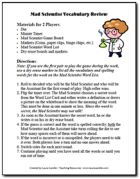
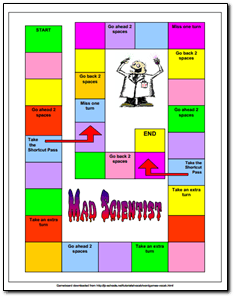
Designed for two players using a list of spelling and vocabulary words provided by the teacher. The game is played according to these directions using the Mad Scientist gameboard shown here.
Visit www.bookadventure.com to learn more about this website. Students can take comprehension quizzes and create personalized reading lists.
Teach students to use a search engine safely and encourage them to research something related to your current topic of study. Students can write a short report about what they learned and include it in their literacy folder.
Display a selection of leveled readers or short nonfiction books related to your weekly theme. Allow students to choose a partner and 2 copies of the book so they can read together. One effective way to do this is to have them sit shoulder to shoulder facing the opposite direction as they look at their own copy of the book. That way they are speaking directly into each other’s ears. After one person reads a long paragraph or short page, the listener asks the reader a question related to the passage. (See bookmark) After the question is answered, the roles are reversed and the listener becomes the reader. Be sure to teach this several times in your whole group lesson before expecting students to do it on their own during center time. For additional accountability, have the students take a comprehension quiz on the Book Adventure site if one is available.
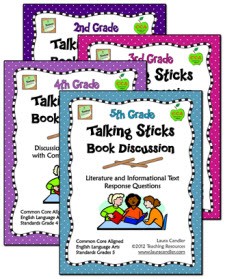 Talking Sticks Discussion (Mini Pack)
Talking Sticks Discussion (Mini Pack)This strategy is a great way to help kids structure their discussions during center time. You’ll need to prepare discussion cards for a reading selection using index cards or a discussion card template. The reading material could be a selection from a basal reader, a newspaper article, an internet article, a poem, or even an audio recording. You might have the students use Paired Reading to read the material, followed by a Talking Sticks Discussion. Print out the directions, prepare the cards, and leave the materials in a center. It’s a good idea to model the Talking Sticks discussion format in a small group setting before assigning it as a center.
Print out the directions and prepare a set of spelling cards using index cards or the template provided. Students will need white boards and dry erase markers for this activity. Model with whole group or in small groups before using as a center.
This is another spelling game that uses spelling cards. The beauty of these games is that you can laminate an envelope with the directions on the front, and all you have to do is create new spelling cards each week. You can even assign that job to a student! For Spin N Spell you will have to print out the gameboard and include a paper clip to use as a spinner (or you can add a commercial spinner if you have one). Students have to spin the pointer, then do one of the 4 tasks. The tasks are to define the word, spell it aloud, write it down, or use it in a sentence. They earn points if they perform the task correctly.
 Create a Character Word Cloud
Create a Character Word CloudThis activity requires an internet connection and the use of a website for creating “word clouds.” See example at right. You can try www.wordle.net, www.taxgedo.com, or www.abcya.com. Students will choose character traits for a given character and will create word clouds in which larger words represent the character traits that best represent the character. Complete directions are included, but you need to try this activity yourself before using it with students. Decide which website you want to use and practice because each website operates a little differently.
All of the files below are in PDF format, so you’ll need the free Adobe Acrobat Reader plug-in to view and print the files. If you have problems, please read the Helpful Hints on the Adobe Acrobat Reader Help page.